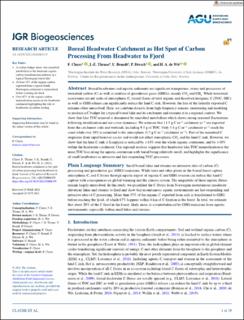| dc.contributor.author | Clayer, Francois | |
| dc.contributor.author | Thrane, Jan-Erik | |
| dc.contributor.author | Brandt, Uta | |
| dc.contributor.author | Dörsch, Peter | |
| dc.contributor.author | de Wit, Heleen | |
| dc.date.accessioned | 2022-01-18T13:51:38Z | |
| dc.date.available | 2022-01-18T13:51:38Z | |
| dc.date.created | 2022-01-05T20:37:49Z | |
| dc.date.issued | 2021 | |
| dc.identifier.citation | Journal of Geophysical Research (JGR): Biogeosciences. 2021, 126 (12). | en_US |
| dc.identifier.issn | 2169-8953 | |
| dc.identifier.uri | https://hdl.handle.net/11250/2838004 | |
| dc.description.abstract | Boreal headwaters and aquatic sediments are significant transporters, stores and processors of terrestrial carbon (C) as well as emitters of greenhouse gases (GHGs), mainly CO2 and CH4. While terrestrial ecosystems are net sinks of atmospheric C, lateral fluxes of total organic and dissolved inorganic C (TOC, DIC) as well as GHG release can significantly reduce the land C sink. However, the fate of the laterally exported C remains often unresolved. Here, we combine datasets from high-frequency sensors, monitoring and modeling to produce a C budget for a typical boreal lake and its catchment and examine it in a regional context. We show that lake TOC removal is dominated by microbial metabolism which shows strong seasonal fluctuations following stratification and ice-cover dynamics. We estimate that 11.5 g C m−2 catchment yr−1 are exported from the catchment soils and wetlands, including 9.5 g of TOC. Only 5.4 g C m−2 catchment yr−1 reach the coast while over 50% is reemitted to the atmosphere (5.7 g C m−2 catchment yr−1). Part of the reemitted C originates from rapid turnover cycles and would not affect atmospheric CO2 and the land C sink. However, we show that the land C sink at Langtjern is reduced by >14% over the whole aquatic continuum, and by >10% within the headwater catchment. Our regional analysis suggests that headwater lake TOC mineralization is the main TOC loss along the aquatic continuum with burial being relatively small, and highlights the significance of small headwaters as intensive and fast-responding TOC processors. | en_US |
| dc.language.iso | eng | en_US |
| dc.publisher | Wiley | en_US |
| dc.rights | Navngivelse-Ikkekommersiell 4.0 Internasjonal | * |
| dc.rights.uri | http://creativecommons.org/licenses/by-nc/4.0/deed.no | * |
| dc.title | Boreal Headwater Catchment as Hot Spot of Carbon Processing From Headwater to Fjord | en_US |
| dc.type | Peer reviewed | en_US |
| dc.type | Journal article | en_US |
| dc.description.version | publishedVersion | en_US |
| dc.rights.holder | © 2021 The Authors | en_US |
| dc.source.pagenumber | 19 | en_US |
| dc.source.volume | 126 | en_US |
| dc.source.journal | Journal of Geophysical Research (JGR): Biogeosciences | en_US |
| dc.source.issue | 12 | en_US |
| dc.identifier.doi | 10.1029/2021JG006359 | |
| dc.identifier.cristin | 1975499 | |
| cristin.ispublished | true | |
| cristin.fulltext | original | |
| cristin.qualitycode | 2 | |

